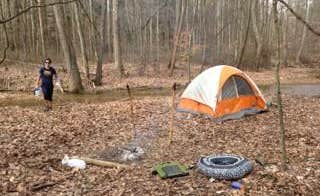Dispersed camping near Clermont, Kentucky provides backcountry experiences in the rugged terrain of southern Indiana. The area features significant elevation changes with hiking trails that can rise 300-400 feet within short distances. Summer temperatures typically range from 75-90°F with high humidity, while spring and fall offer milder conditions but increased precipitation.
What to do
Hiking challenges: The Knobstone Trail offers strenuous terrain for experienced hikers. "The KT is rugged and has lots of elevation gains over short distances. Everywhere you hike there are lovely vistas and lots of fossils on the trail snd creek beds," notes Maris H. about Knobstone Trail.
Wildlife observation: Watch for diverse animal species throughout the hiking routes, but prepare for insects during warmer months. "Watch out for ticks. My dogs and I got loads of them in April 2020 from Leota to Spurgeon Hollow," warns a visitor to Knobstone Trail.
Natural exploration: Look for geological features including fossil beds in creek areas. "There are plenty of great places to camp along the trail. Water can become scarce in the summer/fall months, but if you walk far enough, you're likely to come by a stream of some sort," explains Dave E. about the Knobstone area.
What campers like
Trail accessibility: Multiple access points make it possible to plan section hikes. "There are road crossings every 5 to 10 miles, so if you run out of something or need to bail you can," reports a backpacker at Jackson Trailhead.
Secluded campsites: The dispersed camping areas provide privacy away from developed facilities. "There's parking after a decrepit gravel road and suitable for camping. There are campsites along the trail just have to find them," explains loganx11 about Jackson Trailhead.
Park environment: Some areas offer more developed facilities with family-friendly options. "The entire park is just beautiful. It's very family friendly and quiet. The sites are spacious, and there are a lot of nature things to do," writes Susan C. about her experience.
What you should know
Navigation challenges: Finding trailheads can be difficult without proper directions. "Maybe Google Maps took me to the wrong place (probably not). I drove back and forth on the road several times looking for this place. The only thing I found was what I believe was the entrance with a cable across it," explains Desert B. about accessing camping areas.
Water availability: Water sources vary by location and season. Plan accordingly and bring filtration equipment. "You're never too far from water, although the quality may differ depending on the time of year," notes one experienced hiker.
Conservation rules: The area emphasizes Leave No Trace principles. "The KT asks that you respect leave no trace philosophy, and I felt most hikers did," states a regular visitor to the trails.
Tips for camping with families
Site selection: Choose locations with appropriate amenities for children. Some areas offer more developed options while others are completely primitive. "The sites are spacious, and there are a lot of nature things to do," notes one family camper.
Safety planning: Always inform others of your hiking plans when backcountry camping with children. "Let someone know your itinerary, have a means for filtering water, and enjoy!" recommends a regular visitor to the dispersed camping areas near Clermont.
Trail difficulty assessment: Consider the challenging terrain when planning family hikes. "It's no walk in the park. There are continuous ups and downs that will challenge your leg strength and footing at times," explains a regular on the trails when describing the difficulty level.
Tips from RVers
Access limitations: Most dispersed camping sites near Clermont are not suitable for RVs due to rough access roads and limited parking. "There was no place to park otherwise," notes one visitor attempting to access a trailhead.
Alternative options: Consider using established campgrounds as base camps for day hikes instead of attempting to bring RVs to remote trailheads. The primitive nature of most sites makes them better suited to tent camping or backpacking.


